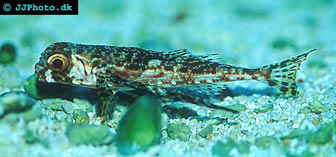Blennies
The common name blenny can easily lead to confusion among aquarists since is has been applied to a lot of different fishes from various families, including freshwater and brackish species as well as marine fish. The term blenny is often ascribed based on similar appearance and behaviour instead of actually genetic relationships.
The so called “true blennies” are found in six families:
Blenniidae
Chaenopsidae
Clinidae
Dactyloscopidae
Labrisomidae
Tripterygiidae
All these families belong to the suborder Blennioidei in the order Perciformes and this suborder currently contains over 800 described species. To avoid misunderstandings, they are often referred to as blennioids rather than blennies by scientists.
Blennoids are typically small with eel-like bodies, blunt heads and big eyes and mouths. The dorsal fin is often long and the tailfin rounded. It is common for the pelvic fins to be short and slender and have a single embedded spine. In many species, the head of the blenny is equipped with “whiskers”, so called cirri.
True blennies are popular among saltwater aquarists since they tend to be colourful and add activity to the aquarium. Male specimens are normally more colourful than the females and also larger. In some species, the male fish will change his colours during the breeding season. It is important to research the species you are interested in before you get blennies, because some species have highly territorial males.
Blennies are usually benthic, which means that they spend a lot of time near or on the bottom.
Some species will burrow in the sand or hide in empty shells or reef crevices. When kept in aquariums, blennies must be provided with suitable hiding spots. Without places to hide, the fish will become highly stressed and this increases the risk of illness.
A lot of blennies are omnivore creatures that feed on algae and tiny aquatic animals. Several species will graze the coral reef free from algae and can help you control excessive algae growth in the aquarium. Always try to mimic the natural diet of your particular blenny species in captivity. If you keep your aquarium virtually algae free, you must compensate by including algae based food and vegetables in the diet. You can for instance attach blanched romance lettuce to a stone and let your blenny “graze”.
Since there are so many true blennies – as well as other species sold as blennies – it is very important to research the specific species you are interested in before you bring it home. It is impossible to provide guidelines that will be true for all blennies out there since they inhabit so many different habitats and have so many different habits. Some blennies are not even suitable for marine aquariums; they should be kept in brackish or fresh water. It is also very important to find out the maximal size of the species. Most blennies are small, but some can become over 30 cm (1 foot) in length.
Blenny articles
Highfin Blenny – A guide to caring for Atrosalarias fuscus
Bicolor Blenny – A guide to caring for Ecsenius bicolor
Midas Blenny – A guide to caring for Ecsenius midas
Redspotted Rockskipper – A guide to caring for Istiblennius chrysospilos
Redlip Blenny – A guide to caring for Ophioblennius atlanticus
Lawnmower Blenny – A guide to caring for Salarias fasciatus
Anthias
Aquarium Chillers
Basses
Batfish
Blennies
Butterflyfish
Cardinalfish
Clown fish
Corals
Damselfish
Files
Goatfish
Gobies
Gorgonians
Grammas
Groupers
Grunts
Hawkfish
Jawfish
Jellyfish
Lionfish
Dragonets
Mantis shrimp
Marine angelfish
Marine Catfish
Moray eels
Nudibranch
Octopus
Pipefish
Protein skimmers
Pufferfish
Rabbitfish
Rays
Snappers
Scorpionfish
Sea Anemones
Sea horses
Sea Stars
Shark Fish
Shrimps
Snails
Squirellfish
Surgeonfish
Triggerfish
Wrasses

